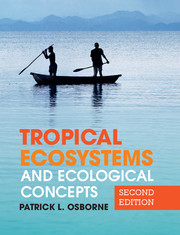Book contents
- Frontmatter
- Contents
- Preface
- Abbreviations and units
- Chapter 1 The tropical environment and climate
- Chapter 2 Dry, hot deserts and environmental factors
- Chapter 3 Grasslands and primary production
- Chapter 4 Savanna and population dynamics
- Chapter 5 Lakes, energy flow and biogeochemical cycling
- Chapter 6 Rivers, floodplains and estuaries
- Chapter 7 Wetlands and succession
- Chapter 8 Tropical rain forests and biodiversity
- Chapter 9 Mountains, zonation and community gradients
- Chapter 10 Mangroves, seagrasses and decomposition
- Chapter 11 Coral reefs and community ecology
- Chapter 12 Islands, archipelagos, biogeography and evolutionary ecology
- Chapter 13 Cities and human ecology
- Glossary
- References
- Index
- References
Chapter 2 - Dry, hot deserts and environmental factors
Published online by Cambridge University Press: 05 June 2012
- Frontmatter
- Contents
- Preface
- Abbreviations and units
- Chapter 1 The tropical environment and climate
- Chapter 2 Dry, hot deserts and environmental factors
- Chapter 3 Grasslands and primary production
- Chapter 4 Savanna and population dynamics
- Chapter 5 Lakes, energy flow and biogeochemical cycling
- Chapter 6 Rivers, floodplains and estuaries
- Chapter 7 Wetlands and succession
- Chapter 8 Tropical rain forests and biodiversity
- Chapter 9 Mountains, zonation and community gradients
- Chapter 10 Mangroves, seagrasses and decomposition
- Chapter 11 Coral reefs and community ecology
- Chapter 12 Islands, archipelagos, biogeography and evolutionary ecology
- Chapter 13 Cities and human ecology
- Glossary
- References
- Index
- References
Summary
Hot desert biomes are found in areas of the world where the average precipitation is below 250 mm per year. However, deserts may occur in areas with rainfall as high as 500 mm per year, particularly if rainfall is patchy with extended dry periods between showers. Rainfall is often not only sparse but also highly irregular in both time and space. Ward et al. (2000) showed a strong negative correlation between the median value of rainfall and its coefficient of variation: areas with low rainfall have high variation. In some deserts, dew deposited during cool nights is the only source of water. During the day, temperatures and evaporation rates are usually very high.
In this chapter, we summarise the ecology of three deserts and discover that, while the shortage of water limits the growth of organisms, it has stimulated the evolution of some remarkable adaptations. Deserts are unfavourable environments and therefore provide a suitable biome to study environmental factors and how they limit the growth, development and distribution of organisms. Water, with its special physical properties, is particularly important to organisms, and plants and animals have developed strategies to control, within limits, the water content of their bodies. Water balance maintenance is intimately linked with the regulation of both body temperature and the osmotic concentration of body fluids. The distribution and growth of plants is affected by soil properties and, in this chapter, the structure, formation, water-holding capacity and nutrient content of soils are described. How do organisms respond to environmental factors? How quickly can organisms respond to a changing environment? How are the resources that plants and animals require distributed temporally and spatially within the environment? These questions are addressed in this chapter.
- Type
- Chapter
- Information
- Tropical Ecosystems and Ecological Concepts , pp. 26 - 58Publisher: Cambridge University PressPrint publication year: 2012



